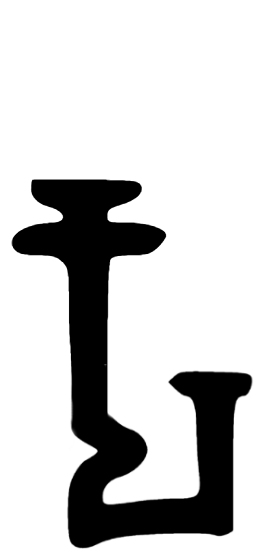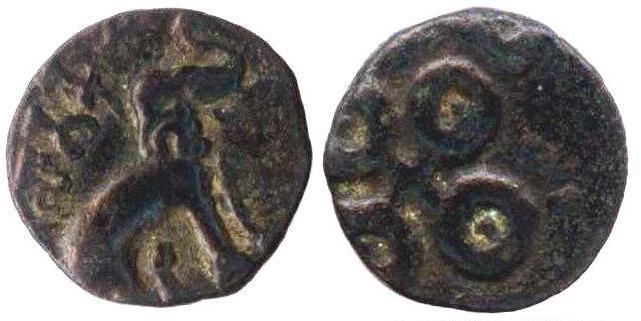|
Jayadaman
Jayadaman was a Western Kshatrapa ruler, although possibly only a Kshatrapa, rather than a Mahakshatrapa. He was the son of Chastana, and the father of Rudradaman I, but he may have pre-deceased Chastana, and never ruled as supreme ruler of the Western Kshatrapas. This is suggested by the fact that Chastana and Rudraman I are known from contemporary Indian inscriptions to have ruled jointly. His diminished title may also have been a consequence of the conquests of the Satavahanas The Satavahanas (''Sādavāhana'' or ''Sātavāhana'', IAST: ), also referred to as the Andhras in the Puranas, were an ancient Indian dynasty based in the Deccan region. Most modern scholars believe that the Satavahana rule began in the lat ... over Kshatrapa territory. The coins of Jayadaman were rather crude, only made of copper and square in form. Notes {{Western Satraps Western Satraps 2nd-century Indian monarchs People from Ujjain ... [...More Info...] [...Related Items...] OR: [Wikipedia] [Google] [Baidu] |
Western Satrap
The Western Satraps, or Western Kshatrapas (Brahmi:, ''Mahakṣatrapa'', "Great Satraps") were Indo-Scythian (Saka) rulers of the western and central part of India (Saurashtra (region), Saurashtra and Malwa: modern Gujarat, Maharashtra, Rajasthan and Madhya Pradesh states), between 35 to 415 CE. The Western Satraps were contemporaneous with the Kushans who ruled the northern part of the Indian subcontinent, and were possibly vassals of the Kushans. They were also contemporaneous with the Satavahana (Andhra in Indian epic literature, Andhra) who ruled in Central India. They are called "Western Satraps" in modern historiography in order to differentiate them from the "Northern Satraps", who ruled in Punjab and Mathura until the 2nd century CE. The power of the Western Satraps started to decline in the 2nd century CE after the Saka rulers were defeated by the Emperor Gautamiputra Satakarni of the Satavahana dynasty. After this, the Saka kingdom revived, but was ultimately destroyed ... [...More Info...] [...Related Items...] OR: [Wikipedia] [Google] [Baidu] |
Rudradaman I
Rudradāman I (r. 130–150) was a Śaka ruler from the Western Kshatrapas dynasty. He was the grandson of the king Caṣṭana. Rudradāman I was instrumental in the decline of the Sātavāhana Empire. Rudradāman I took up the title of '' Maha-kshtrapa'' ("Great Satrap"), after he became the king and then strengthened his kingdom. Reign As a result of his victories, Rudradāman regained all the former territories previously held by Nahapana, except for the southern territory of Poona and Nasik. The indigenous Nagas also were aggressive toward Śaka kshatrapas. Sātavāhana dominions were limited to their original base in the Deccan and eastern central India around Amaravati: War with the Yaudheyas Rudradāman conquered the Yaudheya tribes in present day Haryana, as described in the Girnar rock inscription of Rudradaman. Rudradaman refers to the Yaudheyas as a militant republic of kshatriyas that confronted him as opposed to submitting: However, the Yaudheyas soon r ... [...More Info...] [...Related Items...] OR: [Wikipedia] [Google] [Baidu] |
Western Kshatrapa
The Western Satraps, or Western Kshatrapas (Brahmi:, ''Mahakṣatrapa'', "Great Satraps") were Indo-Scythian (Saka) rulers of the western and central part of India ( Saurashtra and Malwa: modern Gujarat, Maharashtra, Rajasthan and Madhya Pradesh states), between 35 to 415 CE. The Western Satraps were contemporaneous with the Kushans who ruled the northern part of the Indian subcontinent, and were possibly vassals of the Kushans. They were also contemporaneous with the Satavahana (Andhra) who ruled in Central India. They are called "Western Satraps" in modern historiography in order to differentiate them from the "Northern Satraps", who ruled in Punjab and Mathura until the 2nd century CE. The power of the Western Satraps started to decline in the 2nd century CE after the Saka rulers were defeated by the Emperor Gautamiputra Satakarni of the Satavahana dynasty. After this, the Saka kingdom revived, but was ultimately destroyed by Chandragupta II of the Gupta Empire in the 4th cent ... [...More Info...] [...Related Items...] OR: [Wikipedia] [Google] [Baidu] |
Western Satraps
The Western Satraps, or Western Kshatrapas (Brahmi:, ''Mahakṣatrapa'', "Great Satraps") were Indo-Scythian (Saka) rulers of the western and central part of India ( Saurashtra and Malwa: modern Gujarat, Maharashtra, Rajasthan and Madhya Pradesh states), between 35 to 415 CE. The Western Satraps were contemporaneous with the Kushans who ruled the northern part of the Indian subcontinent, and were possibly vassals of the Kushans. They were also contemporaneous with the Satavahana (Andhra) who ruled in Central India. They are called "Western Satraps" in modern historiography in order to differentiate them from the "Northern Satraps", who ruled in Punjab and Mathura until the 2nd century CE. The power of the Western Satraps started to decline in the 2nd century CE after the Saka rulers were defeated by the Emperor Gautamiputra Satakarni of the Satavahana dynasty. After this, the Saka kingdom revived, but was ultimately destroyed by Chandragupta II of the Gupta Empire in the 4th cent ... [...More Info...] [...Related Items...] OR: [Wikipedia] [Google] [Baidu] |
Chastana
Chashtana (Greek: (epigraphic), ; Brahmi: ; Kharosthi: , ) was a ruler of the Saka Western Satraps in northwestern India during 78-130 CE, when he was the satrap of Ujjain. Name Chashtana's name is attested in the Greek forms () and (), in the Brahmi form () and the Kharosthi form (), which are derived from the Saka name , meaning "master". Reign Among modern scholars, the beginning of the Saka era is widely equated to the ascension of Chashtana (possibly to ''Mahakshatrapa'') in 78 CE. A statue found in Mathura together with statues of the Kushan king Kanishka and Vima Taktu, and bearing the name "Shastana" ( Middle Brahmi script of the Kushan period: ') is often attributed to Chashtana himself."The three letters give us a complete name, which I read as Ṣastana (vide facsimile and cast). Dr. Vogel read it as Mastana but that is incorrect for Ma was always written with a circular or triangular knob below with two slanting lines joining the knob" in Chashtana is ca ... [...More Info...] [...Related Items...] OR: [Wikipedia] [Google] [Baidu] |
Satavahanas
The Satavahanas (''Sādavāhana'' or ''Sātavāhana'', International Alphabet of Sanskrit Transliteration, IAST: ), also referred to as the Andhras in the Puranas, were an ancient Indian dynasty based in the Deccan Plateau, Deccan region. Most modern scholars believe that the Satavahana rule began in the late second century BCE and lasted until the early third century CE, although some assign the beginning of their rule to as early as the 3rd century BCE based on the Puranas, but uncorroborated by archaeological evidence. The Satavahana kingdom mainly comprised the present-day Andhra Pradesh, Telangana, and Maharashtra. At different times, their rule extended to parts of modern Gujarat, Madhya Pradesh, and Karnataka. The dynasty had different capital cities at different times, including Pratishthana (Paithan) and Amaravathi village, Guntur district, Amaravati (Dharanikota). The origin of the dynasty is uncertain, but according to the Puranas, their first king overthrew the Kan ... [...More Info...] [...Related Items...] OR: [Wikipedia] [Google] [Baidu] |


